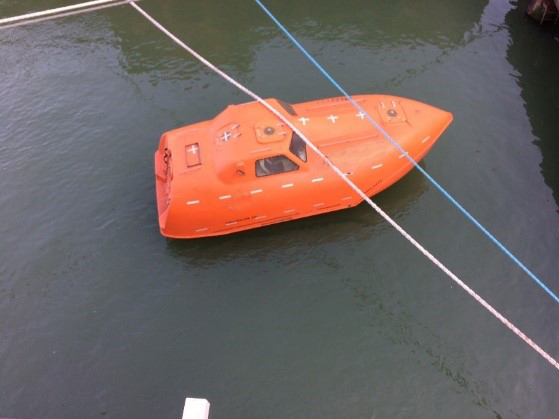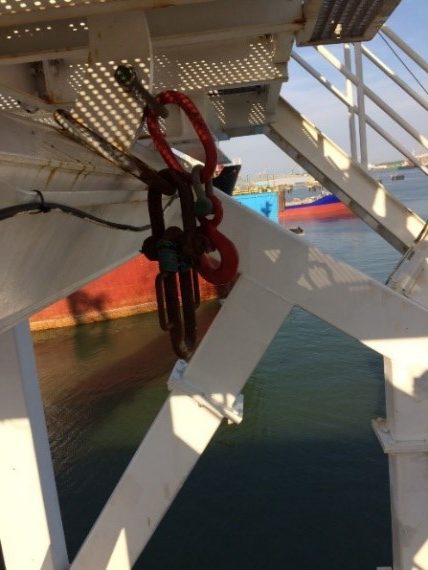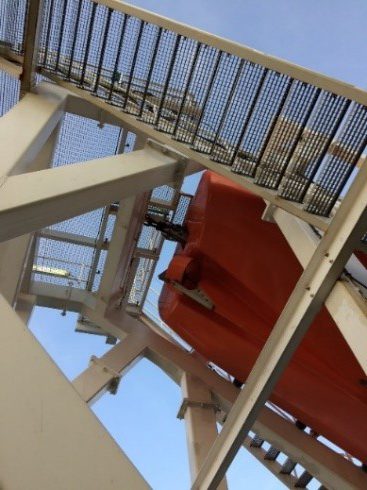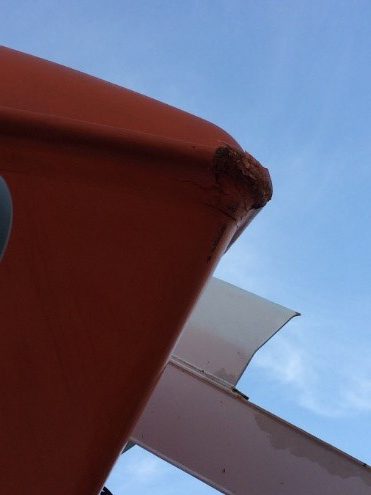Unplanned deployment of free fall lifeboat
What happened?
On a vessel alongside there was an unplanned deployment of a free fall lifeboat (FFB), which no-one was aware of. There were no witnesses to the inadvertent launch, which occurred within a three-hour time window between 1500 and 1800 hrs.
A crew member noticed the boat in the water and investigation began. Crew boarded the lifeboat and it was found that the release hook was still in the locked position and safety pin was in position. Also, the master link in the hook was in good condition. It was not understood how it could have happened. The bow of the lifeboat sustained damage, coming from collision with a barge moored about 20m behind the vessel. The barge was undamaged.
There had been an inspection of the lifeboat earlier in the day but nothing unusual had been noticed. The inspection team did not enter the lifeboat as the maintenance hook was disabled, but no unusual hook configuration was noticed.
The vessel had in recent days come out of dry dock, when there had been an annual inspection of the lifeboat by the manufacturer. That inspection had included a check & test of the boat and the hook. At the end of the docking period, the FFB was placed back on the vessel. Thereafter, the vessel had a short (calm) sea voyage (1 day) to her next port.






What went wrong?
Investigation by both company safety professionals and by the manufacturer revealed no clear root cause or technical defects which might have contributed to the incident. The lifeboat was four years old and complied with all legislation and certification.
What were the causes?
By eliminating the technical failures or human intervention, the only possible explanation is that the master link was not properly placed on the release hook, and gradually slipped out of the hook over time.
What actions were taken?
- Re-assessment and careful positioning of the master link when replacing the lifeboat;
- Temporary downgrade of lifeboat safety certificate (fewer POB);
- Assessment of risk for maintenance (securing) hook to be permanently on the lifeboat when the vessel was at sea (there was no objection from Class). However, it was decided not to do so. The reason for this was the risk following from a more complicated emergency procedure for the crew in emergency was considered too high;
- The maintenance hook to be used always when in port, or during maintenance at sea.
Our member is not satisfied with the current root cause and brings this safety incident to the attention of all IMCA members.
Safety Event
Published: 17 September 2018
Download: IMCA SF 21/18
IMCA Safety Flashes
Submit a Report
IMCA Safety Flashes summarise key safety matters and incidents, allowing lessons to be more easily learnt for the benefit of all. The effectiveness of the IMCA Safety Flash system depends on Members sharing information and so avoiding repeat incidents. Please consider adding safetyreports@imca-int.com to your internal distribution list for safety alerts or manually submitting information on incidents you consider may be relevant. All information is anonymised or sanitised, as appropriate.
IMCA’s store terms and conditions (https://www.imca-int.com/legal-notices/terms/) apply to all downloads from IMCA’s website, including this document.
IMCA makes every effort to ensure the accuracy and reliability of the data contained in the documents it publishes, but IMCA shall not be liable for any guidance and/or recommendation and/or statement herein contained. The information contained in this document does not fulfil or replace any individual’s or Member's legal, regulatory or other duties or obligations in respect of their operations. Individuals and Members remain solely responsible for the safe, lawful and proper conduct of their operations.
